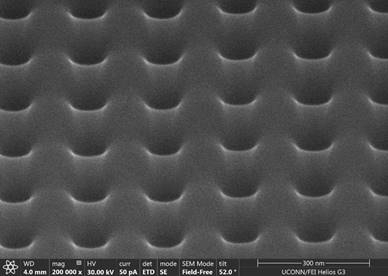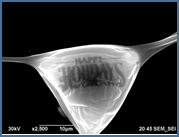Faisceaux d'ions focalisés
Vue d'ensemble
Source: Sina Shahbazmohamadi et Peiman Shahbeigi-Roodposhti-Roodposhti, School of Engineering, University of Connecticut, Storrs, CT
À mesure que les microscopes électroniques deviennent plus complexes et largement utilisés dans les laboratoires de recherche, il devient de plus en plus nécessaire d'introduire leurs capacités. Le faisceau d'ions focalisés (FIB) est un instrument qui peut être utilisé pour fabriquer, tailler, analyser et caractériser des matériaux à l'échelle mico et nanodans une grande variété de domaines allant de la nanoélectronique à la médecine. Les systèmes FIB peuvent être considérés comme un faisceau d'ions qui peuvent être utilisés pour moudre (sputter), déposer et imager les matériaux à l'échelle micro- et nano. Les colonnes ioniques des FIB sont généralement intégrées aux colonnes d'électrons des microscopes électroniques à balayage (SEM).
Le but de cette expérience est d'introduire l'état de l'art dans les technologies de faisceau d'ions focalisés et de montrer comment ces instruments peuvent être utilisés afin de fabriquer des structures qui sont aussi petites que les plus petites membranes qui se trouvent dans le corps humain.
Procédure
1. Fabrication d'un filtre perforé à partir d'une membrane d'oxyde de silicium de 300 nm d'épaisseur comparable à l'échelle du cytoplasme endothélial des reins
- Chargez la membrane préparée dans la chambre FIB. Les membranes sont souvent préparées par des professionnels (lors de la création de ponts Wheatstone) et peuvent être acquises sur les sites de fabrication de semi-conducteurs. Pour en préparer un vous-même, la photolithographie doit être utilisée. Les détails de ce processus peuvent être vus dans la vidé
Applications et Résumé
Cette expérience a démontré comment l'utilisation de microscopes électroniques et de faisceaux d'ions ciblés permet aux chercheurs de manipuler et de fabriquer des structures à microéchelle. La nature moléculaire de l'interaction focalisée entre les faisceaux ioniques et les matériaux confère à la FIB une capacité unique de manipuler des matériaux à l'échelle micro et nanométrique. En examinant attentivement la façon dont le faisceau interagit avec le matériau, en atté...
Passer à...
Vidéos de cette collection:

Now Playing
Faisceaux d'ions focalisés
Materials Engineering
9.0K Vues

Matérialographie optique I : Préparation de l'échantillon
Materials Engineering
15.6K Vues

Matérialographie optique II : Analyse d'image
Materials Engineering
11.2K Vues

Spectroscopie photoélectronique à rayons X
Materials Engineering
21.9K Vues

Diffraction des rayons X
Materials Engineering
89.7K Vues

Solidification directionnelle et stabilisation de phase
Materials Engineering
6.7K Vues

Calorimétrie différentielle à balayage
Materials Engineering
38.7K Vues

Diffusivité thermique et méthode du flash laser
Materials Engineering
13.4K Vues

Dépôt électrolytique sur films minces
Materials Engineering
20.2K Vues

Analyse de la dilatation thermique par dilatométrie
Materials Engineering
16.0K Vues

Spectroscopie d'impédance électrochimique
Materials Engineering
23.4K Vues

Matériaux composites à matrice céramique et leurs propriétés de flexion
Materials Engineering
8.4K Vues

Alliages nanocristallins et stabilité de la taille des nano-grains
Materials Engineering
5.2K Vues

Synthèse des hydrogels
Materials Engineering
23.8K Vues

